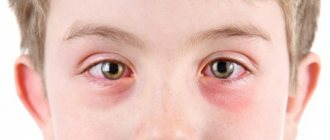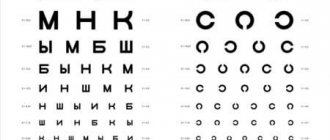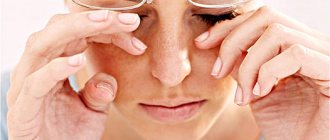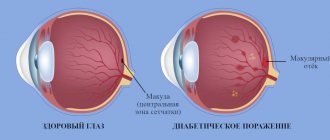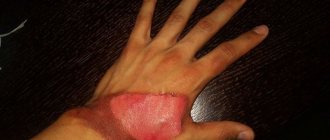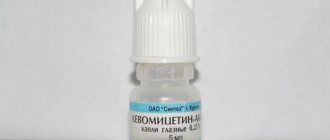Causes Types of disease Symptoms Diagnostics Treatment Our advantages Treatment price
An allergy is the body's hypersensitivity to a specific substance. In the world, the prevalence of allergic diseases has acquired such a scale that they are already classified as diseases of civilization.
Allergy symptoms can be caused by anything - food, cosmetics, pets and plants, household chemicals, etc. The exact reasons for a person’s increased sensitivity to a certain substance are not known for certain; we can only talk about a person’s predisposition to allergies if allergic diseases have been observed, for example, his parents or close relatives suffer from pathologies of the lungs and skin.
Why do allergies appear in the eyes?
Microparticles, volatile organisms or chemical substances constantly accompany a person, wherever he is. They, under favorable circumstances, enter the skin, causing a corresponding reaction. An allergy can occur after this in literally five minutes.
Manifestation of allergies
How do allergens affect:
- Getting on the mucous membrane.
- Through the skin of the eyelids and the mucous membrane of the eyes.
- From the inside, after eating a certain reagent product or medication.
- From insects that bite or carry active substances.
When determining the likelihood of the formation and growth of allergies, it is also important to take into account hereditary factors.
Allergic dermatitis
This is a disease of the eyelids.
Such an acute reaction of the body manifests itself in response to the use of drugs or cosmetics. Allergic dermatitis is characterized by severe redness and swelling of the facial skin, as well as papular rashes accompanied by burning and itching.
Causes of allergies
The human eye is one of the most vulnerable organs to irritating substances. The largest number of allergens are in the air and easily come into contact with the surface of the eyeball. The most common causes of eye allergies are dust, volatile chemicals, animal dander, fungal spores, and pollen. In addition, an allergic reaction in the eye area can occur after consuming certain foods or medications, using hygiene products, decorative cosmetics, or unsuitable contact lenses.
Most often, the disease manifests itself in people with a genetic predisposition to allergic reactions in childhood, after which it can accompany the person throughout his life.
Table: Causes of eye allergies and their descriptions
| Reason name | Description, action, allergens |
| Cosmetics | Products applied near the eyes directly affect the eyelids, eyelashes, eyebrows, but shampoos and even nail polishes act indirectly. Often the reason is not incompatibility with any component, but the quality of the cosmetic or the expiration date. Manifestations: local swelling of the eyelids, “bags” and redness of varying degrees. |
| Food | Products that cause an allergic reaction are very individual for everyone. But there is a standard list of the most “harmful” allergens, which includes eggs, chocolate, berries, citrus fruits, nuts, dairy and seafood. In this case, the allergen affects our mucous membrane through the circulatory system, causing peeling of the skin of the eyelids and its redness. |
| Microorganisms | In particular, these are subcutaneous mites that can live anywhere. In a winter hat, on a pillow, and even in an old glasses frame. In allergy sufferers, these microorganisms cause a severe attack of the disease, which is characterized by all possible signs - from peeling and swelling of the eyelids to pain, lacrimation, and so on. |
| sunlight | Or rather, not the light itself, but its excess. If, for example, you sunbathe on the beach without protective glasses, the first thing that will suffer and begin to become inflamed is the delicate skin of the eyelids. |
| Cold | In winter, the eyelids may turn red and begin to itch, and the eyes may become itchy and watery due to the cold. |
| Water | We are talking about ordinary tap water, which is likely to contain various allergens. If your eyelids are constantly red and itchy, and all tests have been done to no avail and there is nothing left to rule out, try eliminating tap water, replacing it with boiled or mineral water. |
| Contact lenses | You can be allergic to this convenient vision correction tool in principle, or maybe only when unsuitable lenses are used or the technology for their installation is violated. |
| Postoperative period | If surgical procedures were performed on the eyeball, the allergy can definitely be caused by sutures left to dissolve on their own. |
| Medicines | Eye ointments, applicants, drops, gels and medicinal masks can cause a painful reaction of the eyelids if their components are intolerant. In addition, through the blood, medications taken orally can cause an allergic outbreak. |
| Chemical substances | It is clear that if a chemical gets into the eye, it will not just cause an allergy, but a serious burn. In this case we are talking about volatile chemical formations that may be present in the air, for example, in pharmaceutical or chemical production. As they settle on the eyelids, they contribute to the appearance of red, scaly spots or granular rashes. |
| Animals | And also reptiles, birds and other pets that have a lot of allergens: saliva and sweat, fur and skin, coating on feathers. All this, getting on the eyelids, gives an obsessive allergy, accompanied by coughing, irrepressible sneezing and runny nose. |
| Dust | Ordinary house dust, which, no matter how you remove it, still cannot be completely destroyed. Once on the eyelids, it will create pain in the eyes, swelling, itching and “crying”. |
| Plant pollen | For those who suffer from a reaction to it, the spring-summer season is a real test. Accompanied by exacerbation of itchy eyelids, their swelling and the appearance of tears in the eye. |
Types and symptoms of the disease
How does eye allergies manifest? How to treat this disease? We will answer these questions further.
The types of the disease in question are very numerous and varied. Allergies can affect not only the skin of the eyelids, but also contribute to the appearance of severe toxic-allergic keratitis (inflammation of the cornea), uveitis (inflammation of the uvea of the eyes), and also affect the retina and optic nerve.
Fortunately, such forms are not very common. Most often, patients experience allergic dermatitis of the eyelids, as well as numerous types of conjunctivitis. Let us consider the features of these diseases in more detail.
Symptoms of an allergic reaction in the eyes
The speed of development of an allergic reaction in the eyes and its severity depend on several factors, primarily on the method of entry of the allergen into the body, as well as the time of its exposure. If an irritating substance comes into direct contact with the tissues of the eye, an allergy develops immediately, within 5-30 minutes, and if it enters the stomach, symptoms appear after a few hours. The pathology must be treated as soon as the first symptoms appear.
Manifestations of an allergic reaction in the eyes include:
- feeling of itching and burning;
- feeling of “sand” or a foreign object in the eyes;
- swelling, redness of the eyelids and whites;
- increased tearfulness, mucous discharge;
- the appearance of bags and red spots under the eyes;
- photophobia.
The longer the eye tissue is in contact with the allergen, the more pronounced the signs of the pathological reaction are and the more difficult it is to treat the pathology. With moderate manifestations, the so-called effect of tearful eyes is observed, and in severe cases, swelling can be so severe that a person cannot open his eyelids. Sometimes the disease is accompanied by dry skin of the eyelids, the formation of areas of peeling and cracking of the skin - this condition is called eczema of the skin of the eyelids. In addition to a local allergic reaction to the eyes, the pathology can manifest itself as a runny nose, cough, sneezing, rash and swelling on other parts of the body, headache and symptoms of general intoxication of the body.
The allergic reaction develops symmetrically in both eyes - if symptoms are observed only on one side, the possibility of other diseases should be considered.
Watch a video about what causes eye allergies:
Causes of allergic conditions
The anatomical and physiological characteristics of the eyes contribute to the rapid manifestation of allergic reactions. Open mucous membrane, proximity and connection with the nasal cavity, which is so sensitive to allergens: all these factors contribute to the rapid development of the disease.
The main causes of eye diseases of an allergic nature:
- air polluted with allergens. Plant pollen, indoor, industrial or office dust, mold spores and other particles scattered in the air often cause eye allergies.
- food allergy. A food product eaten when the body is hypersensitive to its ingredients can also cause symptoms of eye allergies.
- allergies to medications. Allergies can occur even to medications prescribed by a doctor, and sometimes to allergy medications.
- contact allergy. New eye cream, serum, eye shadow or mascara and other cosmetics cause the rapid appearance of allergic symptoms.
- allergies to sun and cold. The body's sensitivity to weather conditions is often reflected in the condition of the eyelids and eyeballs.
- use of unsuitable contact products for vision correction - soft or hard contact lenses, as well as care products for them.
Why are eye allergies dangerous?
An allergic reaction to the eyes itself is not dangerous if the swelling does not spread to the respiratory system. But in people who suffer from this disorder regularly, the manifestations become more intense and one day anaphylactic shock may occur. Therefore, the pathology needs to be treated as soon as possible.
Against the background of constant allergies, a person’s immunity decreases, chronic fatigue and irritability appear, and constant exposure to allergens on the body leads to the development of bronchial asthma and other dangerous diseases. Severe manifestations of an allergic reaction cause conjunctivitis, which can become chronic - the disease not only causes serious discomfort, but can also lead to deterioration of vision. He needs to be treated immediately.
Constant exposure to allergens on the body leads to the development of bronchial asthma
For this reason, allergies on the eyelids cannot be ignored - at the first manifestations, you should contact an allergist and undergo the necessary tests to identify the substance that provokes the pathological reaction. Then begin to treat the disease.
Modern complex pharmacotherapy of allergic eye diseases
Epidemiological studies around the world indicate a global increase in the incidence of allergic diseases. The relevance of the problem of allergic eye diseases is increasing as new data emerge on the role of allergic reactions in the pathogenesis of eye lesions in a wide variety of eye diseases of infectious and non-infectious nature. The article presents pharmacotherapy regimens for the most common clinical forms of allergic conjunctivitis.
Table 1. Types of ocular allergies depending on causative factors
Table 2. Clinical forms of corneal pathology in atopic keratoconjunctivitis
Allergic conjunctivitis affects approximately 15% of the population and is a common problem in ophthalmology and general medical practice [1]. Seasonal allergic conjunctivitis affects 21% of Britons and 20% of Americans [2]. According to epidemiological studies, rhinoconjunctivitis is observed on average in 16.5% of Russians.
Treatment of allergic eye diseases seems to be a difficult task due to the persistently relapsing course of the disease and the variety of clinical forms due to many etiological factors (Table 1), as well as the fact that the lesion can affect any part of the organ of vision: the skin of the eyelids, conjunctiva, cornea, choroid, retina, optic nerve.
Drugs for the treatment of allergic eye diseases
Antihistamines and agents that inhibit mast cell degranulation are used as basic pharmacotherapy.
Antihistamine eye drops, often additionally containing a vasoconstrictor component, have the fastest effect. In acute allergic conjunctivitis, such drops block H1 receptors for histamine, reduce the tissue reaction to histamine and have an antiallergic effect within a few minutes: they reduce itching and swelling of the eyelids, lacrimation, hyperemia and swelling of the conjunctiva. From this group of drugs, French eye drops Spersallerg (antazolina hydrochloride + tetrizoline hydrochloride) and domestic Polynadim (diphenhydramine + naphazoline) are widely used in Russia.
Eye drops that inhibit mast cell degranulation (Cromohexal) contain a 2% solution of disodium cromoglycate. Cromoglycate inhibits the release of histamine and other mediators from mast cells. Cromoglycates have a preventive mechanism of action; the therapeutic effect develops slowly, but it is longer lasting than that of antihistamine eye drops.
In recent years, eye drops with double and triple mechanisms of antiallergic action have been used. The first (these include Opatanol (olopatadine hydrochloride)) selectively block H1 receptors and stabilize conjunctival mast cells. The latter (for example, Zaditen (ketotifen hydrofumarate)) have antihistamine activity, have a stabilizing effect on the membranes of conjunctival mast cells and suppress the migration of eosinophils. Antiallergic therapy also includes the first stable eye drops containing genetically engineered interferon alpha-2a and a high concentration (0.001 g/ml) of the antihistamine diphenhydramine (Ophthalmoferon).
In the treatment of allergic diseases, it is important to choose the right additional medications: glucocorticosteroids, non-steroidal anti-inflammatory drugs, immunosuppressants, tear replacement drugs, etc.
Glucocorticosteroids are widely used locally (drip, in the form of subconjunctival and parabulbar injections), as well as systemically (orally and parenterally) for the treatment of allergic eye lesions. Glucocorticosteroids play a significant role in the treatment of uveitis and scleritis, keratitis and conjunctivitis. As a rule, these drugs are used in the treatment of allergic diseases that occur in the form of delayed-type hypersensitivity, in emergency conditions (anaphylactic shock, status asthmaticus), corneal transplant rejection reactions and autoimmune diseases. Currently, a large group of synthetic glucocorticosteroids is used: betamethasone, dexamethasone, methylprednisolone, prednisolone, triamcinolone. The dose of hormones, the schedule and method of administration depend on the severity and type of disease. It should be noted that even with local long-term hormonal treatment, in addition to anti-inflammatory and antiallergic effects, side effects often occur - intraocular pressure increases, cataracts and ophthalmic herpes worsen. In addition, there is a high probability of developing bacterial conjunctivitis and keratitis due to suppression of local immunity.
Non-steroidal anti-inflammatory drugs (diclofenac, indomethacin) are characterized by a pronounced anti-inflammatory effect and are devoid of side effects similar to those that occur with the use of glucocorticosteroids. These drugs are prescribed for the complex treatment of severe infectious conjunctivitis, corneal ulcers, uveitis, as well as severe allergic keratoconjunctivitis.
Immunosuppressants can be used for allergic eye lesions that are resistant to other types of therapy, as well as for autoimmune keratitis and uveitis.
As our observations have shown, allergic eye diseases are often accompanied by impaired tear production. That is why we recommend adding tear replacement therapy to the basic therapy from the first day of treatment and continuing it for a long time.
For infectious-allergic and allergic conjunctivitis, complicated by a bacterial infection, antibacterial drugs are added to antiallergic drugs. However, as our studies using skin tests have shown, 30% of patients with allergic conjunctivitis show increased sensitivity to the preservative included in antibacterial eye drops.
In this regard, the role of antiseptic eye drops with a wider spectrum of antimicrobial action compared to antibiotics is increasing in medical practice. Some of them do not contain preservatives, for example the French drug Vitabact (picloxidine dihydrochloride) and the domestic Okomistin (Miramistin). Okomistin drops are intended for the treatment and prevention of infectious and inflammatory eye diseases. The drug simultaneously acts on viruses, bacteria, fungi and protozoa. Okomistin is a one-component drug, does not contain preservatives and is well tolerated.
Treatment regimens for allergic conjunctivitis
Let's consider treatment regimens for the most common allergic conjunctivitis, depending on the clinical form.
Hay conjunctivitis
This seasonal eye disease is caused by pollen during the flowering period of grasses, cereals, and trees. The time of exacerbation is closely related to the plant dust calendar in each climatic region. The acute course of hay fever conjunctivitis (unbearable itching of the eyelids, burning of the eyes, photophobia, lacrimation with severe swelling and redness of the mucous membrane of the eyes) is observed only in 5.2% of cases. In the area of the upper cartilage, papillary hypertrophy is noted. Pollinous conjunctivitis is often combined with rhinitis, dermatitis, and bronchial asthma. However, according to our observations, usually allergic conjunctivitis, including hay fever, occurs in a chronic form (moderate burning under the eyelids, slight discharge, periodic itching of the eyelids). Often numerous complaints are combined with a mild clinical picture.
The choice of local basic therapy for pollinous conjunctivitis is determined by the course of the disease: for chronic cases, Opatanol or Lecrolin (sodium cromoglycate) is recommended 2 times a day, for acute cases - Polinadim or Oftalmoferon 2-3 times a day (for severe cases, it is advisable to combine them with Opatanol).
As additional therapy for severe hay fever conjunctivitis, oral antihistamines should be used, as well as Oftan Dexamethasone (dexamethasone sodium phosphate), Dexapos (sodium dexamethasone-21-sulfobenzoate), Diclofenac (diclofenac sodium), Indocollir (indomethacin) drops 3 times in a day; for blepharitis - hydrocortisone ointment on the eyelids 2 times a day; in case of disruption of the tear film - Hypromellose (hypromellose), Oftolik (povidone + polyvinyl alcohol), Hypromellose-P (hypromellose), Systane (polydronium chloride, polyethylene glycol, etc.), Oftagel (carbomer 974P) or Hilo-Komod (sodium hyaluronate). For the prevention and/or treatment of secondary bacterial infections, Okomistin 1-2 drops 3 times a day is recommended.
Vernal keratoconjunctivitis (spring catarrh)
The disease is characterized by pronounced seasonality: it begins in early spring (March–April), reaches a maximum in summer (June–August), and regresses in autumn (September–October). It begins with a slight itching in the eyes, which progressively increases and becomes unbearable. Characterized by a significant increase in itching in the evening. Excruciating itching is accompanied by a thread-like discharge. Thick white threads of mucous discharge can form spiral-shaped accumulations under the upper eyelid, which causes particular concern to patients. The most characteristic clinical sign is papillary growths on the conjunctiva of the cartilage of the upper eyelid (conjunctival form). The growths are small, flattened, sometimes large, deforming the eyelid. Less commonly, papillary growths are found along the limbus (limbal form). There is also a mixed form. The cornea is often affected (epitheliopathy, corneal erosion, keratitis, corneal ulcer, hyperkeratosis).
As a means of basic therapy for mild cases of spring catarrh, Lecrolin and Cromohexal are used 3 times a day for 3–4 weeks; for severe cases, Polinadim, Zaditen or Opatanol are used 2 times a day, dexamethasone preparations (Oftan Dexamethasone or Maxidex) 2–3 times per day, Diklo-F or Indocollir 2 times a day.
Additionally, antihistamines may be prescribed orally. For corneal ulcers - Diklo-F or Indocollir and reparative agents - Balarpan (sulfated glycosaminoglycans) or Solcoseryl ophthalmic gel (deproteinized dialysate from the blood of healthy dairy calves) 2 times a day. If tear production is impaired, use artificial tear preparations (Defislez, Oftolik, Gipromeloza-P, Systane, Hilo-Komod or Oftagel). In case of secondary infection, Okomistin 1-2 drops 3 times a day.
Drug-induced allergic conjunctivitis
This type of conjunctivitis of allergic origin can occur in an acute form after the first use of any medicine and even be accompanied by severe symptoms of a general disease. However, chronic conjunctivitis develops more often with long-term use of the drug, and an allergic reaction can occur to both the main drug and the preservative.
First of all, it is necessary to eliminate the allergen (stop taking the drug that caused the allergic reaction). For acute drug-induced allergic conjunctivitis, use Polinadim, Zaditen or Opatanol 2-3 times a day, for chronic - Lecrolin or Cromohexal. If necessary, antihistamines can be added orally.
As an additional therapy, local use of glucocorticosteroids is recommended - the drugs Oftan Dexamethasone or Maxidex; in case of disruption of the tear film, Hilo-Komod, Defislez, Oftolik, Hypromeloza-P, Systane are prescribed.
Atopic keratoconjunctivitis (AKK)
ACC is a bilateral inflammation of the eyelids, conjunctiva, and cornea, clearly associated with atopic dermatitis. Skin lesions of the eyelids may take the form of eczematous dermatitis, characterized by dry, inflamed skin with scales. In ACC, dysfunction of the meibomian glands, keratinization, and impaired tear film formation often occur. Possible swelling of the conjunctiva with a typical papillary reaction, which is more pronounced on the conjunctiva of the lower eyelid. Clinical forms of corneal changes in ACC according to severity are given in Table. 2. ACC is a severe ophthalmic pathology that requires complex therapy, necessarily including glucocorticosteroids, depending on the clinical course and the nature of complications.
In mild cases of ACC, it is recommended to instill Lecrolin or Cromohexal eye drops 3 times a day, in severe cases - Polinadim 2 times a day for 7 days, Zaditen, Opatanol 2-3 times a day. In the case of a secondary herpetic infection, Oftalmoferon is prescribed 6 times a day, Zovirax (acyclovir) eye ointment 3 times a day, Valtrex (valaciclovir hydrochloride) orally 500 mg 2 times a day for 5 days. For secondary bacterial infection - antimicrobial drugs containing levofloxacin (Signicef, Oftaquix), tobramycin (Tobrex) or Okomistin 3 times a day, complex anti-inflammatory and antibacterial therapy can also be carried out - “dexamethasone + ciprofloxacin” (Combinil-Duo) 3 times a day or “dexamethasone + tobramycin” (Tobrason) 3 times a day.
Additionally, antihistamines may be prescribed orally; local glucocorticosteroids - Oftan Dexamethasone or Maxidex 2-3 times a day, non-steroidal anti-inflammatory drugs - Diklo-F or Indocollir 2 times a day. For corneal ulcers, reparative agents are indicated - Balarpan or Solcoseryl 2 times a day, for impaired tear production - artificial tears (Defislez, Oftolik, Hypromeloza-P, Systane, Hilo-Komod or Oftagel).
Infectious conjunctivitis complicated by an allergic reaction
Allergy plays an important role in the clinical picture of many acute and chronic infectious diseases. As shown by many years of experience in the Department of Infectious and Allergic Eye Diseases of the Moscow Research Institute of Eye Diseases named after. Helmholtz, an allergic reaction is an essential component of the clinical picture of infectious conjunctivitis, and is characterized by an acute or subacute onset, deterioration in the dynamics of the disease during treatment, mucopurulent discharge, swelling of the eyelids, narrowing of the palpebral fissure, single small follicles, papillary hypertrophy of the upper eyelid.
The use of antiallergic ophthalmic drugs should be considered as a pathogenetic treatment, regardless of whether the allergic reaction is a manifestation of an eye infection or a reaction of eye tissue to the toxic-allergic effects of previous long-term therapy.
As basic therapy for herpes infection, Oftalmoferon 3-4 times a day, Zovirax ointment 3 times a day, Valtrex orally 500 mg 2 times a day for 5 days are indicated; for adenovirus infection - Oftalmoferon as monotherapy or in combination with Okomistin 8-10 times a day; for a bacterial infection - Signicef, Oftaquix, Tobrex or Okomistin, 1-2 drops 3 times a day. In severe cases, broad-spectrum antibiotics for systemic use should be prescribed. Among the means of antiallergic therapy, Polinadim 2 times a day for 7 days, Zaditen or Opatanol 2-3 times a day are recommended.
It is also possible to use both oral antihistamines and non-steroidal anti-inflammatory drugs - Diklo-F or Indocollyr 2 times a day. As in the case of other forms of allergic conjunctivitis, in case of infectious conjunctivitis complicated by an allergic reaction, reparative agents (Balarpan or Solcoseryl 2 times a day) and artificial tear preparations (Defislez, Oftolik, Hypromeloza-P, Systane, Hilo-Komod or Oftagel).
Thus, the treatment of allergic conjunctivitis, regardless of its etiology, form and severity, should be comprehensive and include an impact on all parts of the pathogenesis of the disease.
Diagnostics
Despite the fact that the symptoms of the disease are usually obvious, it is necessary to undergo a serious examination to identify the cause of the exacerbation. Allergies need to be treated after the allergen has been identified. The set of diagnostic measures includes:
- interviewing the patient and recording his complaints;
- blood tests, from general to biochemical;
- blood required for allergy tests;
- Analysis of urine;
- swab-scraping from the surface of the conjunctiva;
- study of the composition of tear fluid to determine the number of eosinophils;
- biomicroscopy is a special study of the conjunctiva, as well as the edge of the eyelid, cornea and ciliary area;
- examination by an ophthalmologist;
- examination by an ENT doctor;
- immunogram;
- appointment with an allergist.
Basic information
Before we tell you about how to treat allergies on the eyelids, we should tell you what this pathological condition is.
The word "allergy" is of Greek origin. Translated into Russian, the first part of this term means “other”, “stranger” or “different”, and the second part means “impact”.
Allergy is a hypersensitivity of the human immune system, which manifests itself as a result of repeated exposure to an allergen on an organism previously sensitized by it.
How to treat eye allergies
The purpose of diagnostic measures is to determine the allergen. This is done in order to eliminate allergic contact during treatment and later, in order to prevent relapse. If the reason is cosmetics or medicine, you need to stop using it. If the allergen is a food product, it is removed from the diet. If the reaction occurs to the fur or secretions of pets, it is necessary to limit contact with them. It is necessary to treat only after the “provocateur” has been eliminated.
To completely get rid of an allergic reaction, you must first eliminate its cause, that is, eliminate contact with the allergen. To combat the manifestations of the disease (swelling, itching, inflammation), an integrated approach is used. To treat the disease, eye drops, ointments, oral medications and other medications are used.
Anti-allergy eye drops
Eye drops are one of the most effective remedies against eyelid allergies, as they act directly on the affected areas and quickly relieve discomfort. These drugs have different mechanisms of action, and, based on this, are divided into several groups.
Table: Groups of eye drops for allergies
| Group of drugs | Drug names | Features of impact and application |
| Vasoconstrictors | "Octilia", "Naphthyzin", "Okumetil", "Vizin" | Relieves swelling and redness of the mucous membrane by constricting blood vessels. You can use these products for no more than 2-3 days, as prolonged use can cause withdrawal syndrome - a sudden return of allergy symptoms |
| Antihistamines | "Ketotifen", "Azelastine", "Lecrolin", "Olopatadine" | They block the release of a substance called histamine, which is a catalyst for an allergic reaction, and effectively relieve itching and inflammation. Recommended as a first aid remedy for eye allergies |
| Non-steroidal anti-inflammatory drugs | "Acular", "Diclofenac" | They reduce the manifestations of an allergic reaction and have a quick effect. Can only be used with a doctor's prescription |
| Corticosteroid drugs | "Maxidex", "Dexamethasone" | The drugs are based on synthetic analogues of adrenal hormones, which effectively suppress the inflammatory process and eliminate discomfort. They have a large number of side effects, so they are not recommended for long-term use |
| Mast cell stabilizers | "Alomid", "Lecrolin", "Cromhexal" | Drugs that provoke changes in mast cells, from which histamine is released. Drugs in this group have a cumulative effect, that is, they begin to act only after a certain period of use, so they are recommended to be taken before the allergy season to eliminate discomfort |
| Tear substitutes | "Systane", "Artificial tear", "Vidisic" | They eliminate dry eyes, relieve inflammation and itching, but often have no effect in cases of serious allergies. The safest drugs that can be used regularly |
It is strictly not recommended to treat allergies with eye drops without a doctor’s prescription, as self-medication can aggravate the disease and cause complications.
Apply drops to your eyes only with clean hands, without exceeding the recommended dosage, and do this so that the product gets into the pocket of the lower eyelid.
In addition to drops, allergies can be treated using ointments and oral products, which in combination with drops have an effective effect.
- Ointments and creams. Local antiallergic agents are also divided into non-hormonal (Fenistil, Psilo-Balm) and hormonal, based on corticosteroid hormones - Advantan, Sinaflan, Dex-gentamicin. Allergies can be treated with drugs of the second group only after consultation with a doctor, since the skin on the eyelids is very sensitive.
- Pills. Oral preparations are especially effective in cases where the allergen entered the body through the stomach. The most common of them include Claritin, Suprastin, Loratadine. Do not forget that antihistamine tablets can cause drowsiness, so during therapy it is better to refrain from driving vehicles or performing dangerous work.
The duration of administration and dosage depend on the severity of the allergic reaction and are determined by a specialist. Allergies should be treated until symptoms disappear completely.
Seasonal allergies to flowers
The most common type of allergy is hay fever, or seasonal allergic rhinoconjunctivitis. It is also popularly called “hay fever”. Hay fever always occurs at the same time of year and is the body’s reaction to the flowering of certain plant species. These can be trees (birch, alder, linden, poplar), cereals (barley, rye, oats, wheat), weeds (ragweed, quinoa, wormwood). Manifestations of allergies to flowering include redness of the skin around the eyes, severe runny nose, various dermatitis, conjunctivitis, sore throat, cough, sometimes even asthma attacks. Often, the signs of hay fever are confused with manifestations of ARVI and they do not immediately consult a doctor, trying to be treated with completely different drugs. The difference may be indicated by the absence of temperature, which does not occur with seasonal rhinoconjunctivitis, or the increase is several tenths of a degree.
To determine the cause, special scarification tests are performed. Small scratches are made on the patient's forearm, after which a possible allergen is applied to each. If the reaction is positive, hyperemia will develop around it, causing the skin to become very red. There is also a method for determining specific antibodies of the IgE class in blood serum, which is used in cases where it is not possible to carry out the first type of testing.
For hay fever, a course of antihistamines, various creams and sprays, as well as adsorbents are prescribed to remove the allergen from the body. In severe cases, corticosteroids are used. During this period, doctors recommend refraining from long walks or leaving the area, washing clothes more often and taking a shower to get rid of stuck pollen particles.
Unfortunately, hay fever cannot be cured radically; you just have to survive it for a certain period of time.
Treatment of allergies with folk remedies
Folk remedies are also used to treat eye allergies. They are able to eliminate local manifestations of the disease, but do not act on its cause, so they should be used in combination with antihistamines.
- Chamomile. Chamomile decoction is an effective remedy for allergies, which is recommended even by doctors. It has an anti-inflammatory and antiseptic effect, due to which it relieves swelling and stops the inflammatory process. Allergies can be treated with a decoction. To prepare it, take a tablespoon of color, pour a glass of boiling water, leave for half an hour, cool and use for eye wash or lotions.
- Fresh vegetables. Cabbage, potatoes and cucumber can also be used to treat the disease. They soothe inflamed skin, eliminate itching and redness. Wash, peel, grate the vegetables and apply the paste to the inflamed eyelids for 15-20 minutes.
- Kalanchoe. Kalanchoe is another well-known folk remedy that helps treat allergies. Take a fleshy leaf of the plant, wash, chop, squeeze out the juice, and then wipe your eyes with it 2-3 times a day.
- You can make lotions from a decoction of dill seeds.
- Boiled or baked onions are mixed with honey and applied to the eyelids.
- To remove toxins, you need to cook oatmeal jelly from a glass of cereal (not cereal).
- Chicory and dandelion root also release toxic substances.
- Fresh birch sap will help relieve itching.
- Inflammation and itching can be removed by applying a weak soda solution as applications.
- You can apply bread chilled in the refrigerator to your eyelids to relieve itching.
- A decoction of parsley is suitable as a compress.
- Olive or fir oil will relieve irritation of the eyelids.
- You can use mummy dissolved in water for applications.
- Boric acid. If the allergy is accompanied by purulent discharge from the corners of the eyes, then it can be treated with a weak solution of boric acid (the main thing is to be careful not to burn the delicate skin).
If a child has an eye allergy, treating him with folk remedies is strictly prohibited. Swelling in the facial area is very dangerous in childhood, so you should consult a doctor as soon as possible.
Watch a video about what to do at home if your eyes itch due to allergies:
Precautions when using folk remedies
Typically, traditional methods of treatment and herbs do not provoke the appearance of negative reactions. However, it is not worth treating conjunctivitis with folk remedies without consulting a specialist. Only a doctor is able to assess the possible risks and include in the drug treatment regimen those traditional medicines that will not cause harm and will help you quickly get rid of viral conjunctivitis.
To avoid consequences, it is worth conducting a test. It is better to first try each folk remedy on one eye and monitor the body’s reaction. If there is no burning, swelling and other unfavorable symptoms, you can use these traditional medicines to treat conjunctivitis.
Properly selected remedies can reduce unpleasant symptoms and relieve allergic conjunctivitis in a short time. However, it is better not to rely entirely on herbal medicines and combine the treatment of conjunctivitis with traditional recipes with medications prescribed by a specialist.
General recommendations
To treat the pathology and eliminate an allergic reaction in the eyes as quickly as possible, the following recommendations must be followed:
- drink as much water as possible to remove toxins from the body;
- if the allergen has entered the body through the gastrointestinal tract, in addition to antihistamines, you should take any adsorbent (activated carbon, etc.);
- when going outside, protect your eyes with dark glasses;
- if you have started to treat an allergic reaction, you cannot use hygiene products, medicinal and decorative cosmetics (you can only wash your face with boiled or bottled water), and refuse contact lenses;
- daily carry out wet cleaning and ventilation in the room where the patient is located.
If the swelling spreads very quickly, the patient should be taken to the doctor as soon as possible (not treated independently), as such a situation can pose a serious threat to life. You can first inject him with a hormonal drug intramuscularly (for example, Prednisolone), which will slow down the rate of the allergic reaction.
Causes
How to treat eyes swollen from allergies?
Before answering this question, you should find out why such irritation occurs in the first place.
According to experts, due to their physiological characteristics, the human visual organs are very vulnerable to the effects of certain allergens. By the way, the latter can be in the air in large quantities. Easily coming into contact with the surface of the eyes and nose, they cause quite unpleasant sensations.
In addition to the air around a person, other factors can also act as an allergen.
Experts believe that the most common of them are: mold, household dust, animal hair, volatile chemicals and pollen.
Most often, allergies in the eyes of children (we will tell you how to treat such irritation below) appear due to dust. This condition is characterized by severe redness of the mucous membrane of the visual organs, as well as burning and itching.
Very often, the cause of allergic reactions in the eyes are allergens that enter the human body through other means (for example, through food, insect bites, medications, etc.).
Often this unpleasant condition is provoked by substances that are in close contact with the skin of the eyelids and the surface of the eyes.
As a rule, these include cosmetics (for example, mascara, cream, eye shadow, eyeliner pencil, etc.), as well as medications intended for the visual organs (drops, ointments, gels, etc.).
Prevention
Allergies are not a disease that can be easily prevented by preventive measures. But if a person is prone to it, he should follow some measures that will help, if not avoid exacerbation completely, then significantly reduce its manifestations.
- Always carry antihistamines with you so that you can immediately begin to treat the disease if necessary.
- Minimize or eliminate the use of decorative makeup, or at least use trusted brands. It is best to give preference to products labeled “Hypoallergenic”.
- During the spring flowering season, do not try to spend too much time in the fresh air. You can only walk if there is not the slightest wind outside. And you shouldn’t ventilate the room often in windy weather.
- Wash your hands after walking, eating, or doing any housework.
An allergy to the eyes is not just a state of discomfort that can be eliminated with drops and tablets, but a signal from the body about a serious disruption of its functioning. For this reason, at the first symptoms of an allergic reaction, you should consult a doctor and undergo a full examination of the body.
Watch a video about eye allergy symptoms:
Which doctors should I contact if I have an eye allergy?
Primary care physicians (internists) and allergists are well versed in diagnosing and treating allergies. However, when allergic eye symptoms begin to worsen, it is usually recommended to involve an eye doctor or ophthalmologist.
Eye doctors have a better understanding of eye diseases and are better prepared to deal with allergic conjunctivitis. In addition, they have special equipment and examination devices that allow them to examine the eye to rule out serious complications that can sometimes affect the eye and threaten vision.
Basic information
In the modern world, allergies can overtake everyone at every turn. The forms of its expression are varied. The most common allergy is to the eyes. The mucous membrane of the eyes is poorly protected and is a vulnerable place for allergy damage.
And the skin around the eyes is considered the most delicate and sensitive area.


